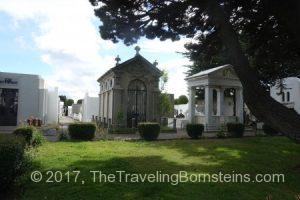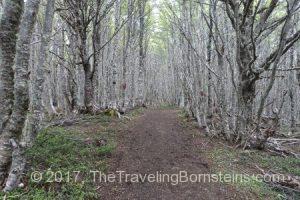Punta Arenas, Chile’s southernmost city, is the capital of Magallanes province. Its location on the Strait of Magellan between the Pacific and Atlantic Oceans makes it a prime destination for South American cruise ships rounding Cape Horn and for Antarctic bound passengers. The small city is inundated with tourists, hikers, and wildlife explorers who take advantage of Chile’s summer months (November to early March).
Since I had previously spent a day with Magellanic penguins in Puerto Madryn, Argentina, I passed on the popular Isla Magdalena excursion. Instead, I took a self-guided walking tour of the city. Before leaving the port, I looked at the billboard-sized map that was prominently displayed outside the visitor center. I also followed the signage that led to the handful of notable sites. It’s impossible to get lost In Punta Arenas.
Plaza De Armas and the Ferdinand Magellan Statue

My first stop was the main square, Plaza De Armas, Munoz Gamero. I was curious to see if people actually came to the park to touch or kiss the foot of Ferdinand Magellan’s statue. I stood in disbelief. To this day, some people come to the statue with the hope that it will bring good fortune and an unexpected return to the city.
Palacio Sara Braun
Palacio Sara Braun, one of Punta Arenas’ landmarks, is adjacent to the park. Sara Braun, the widow of Jose Nogueira, built this nineteenth century home. Nogueira was a successful businessman who made his fortune in gold exportation and raising sheep. His premature death left his wife in charge of finishing the luxurious home and managing his assets.

The French architect, Numa Mayer, incorporated a neo-classical style that corresponded to the Greek-Roman period. All the exterior and interior materials were transported from Europe. Around the time of completion, the perimeter of the main square was filled with brick mansions, residences, and commercial institutions.
For a nominal fee, we toured the inside of this well maintained home. Like other European styled homes from this era, the ceilings were high and adorned with multiple layers of molding. A few vertical columns added an extra touch of sophistication. The oversized rooms had detailed wood trim that was a prominent feature on many of the walls and doorways. The furnishings, wall pictures, and miscellaneous artifacts reflect early 20th century living.
Several of the neighboring buildings surrounding the park had plaques that described their historical relevancy. Unfortunately, all were in Spanish.
Punta Arenas Cemetery

I followed the street signs to the Cementerio Monumento Nacional (the Punta Arenas Cemetery). It was about a 20-minute walk. This cemetery also dates back to the 19th century. Manicured dark green Cyprus trees stood in sharp contrast to the white and gray mausoleums that are resting place for immigrants, pioneers and notable families. Sara Braun donated the portico and perimeter walls.
Surprisingly, one of the most popular places in town is the cemetery. While it is considerably smaller than the well-known La Recoleta Cemetery in Buenos Aires, it has a similar feel.
Reserva Nacional Magallanes—Sector Las Minas
This 2.2 kilometer, user-friendly trail is located in the Reserva Nacional Magallanes. Near the base restrooms one can find informative signs in English and Spanish that provide insight into the three climates in the park and the native flora and fauna.
After entering the trailhead, we trekked through open meadows that were bordered by a  few tree clusters. Eventually, we approached a heavily wooded area. Several types of moss covered the ground and vegetation. The trees formed a natural archway over the muddy path. Although the path was well worn, there were red trail markings on the trees.
few tree clusters. Eventually, we approached a heavily wooded area. Several types of moss covered the ground and vegetation. The trees formed a natural archway over the muddy path. Although the path was well worn, there were red trail markings on the trees.
At the end of the trail, we entered another open area. Gusty winds and an overcast sky prevented us from getting a clear view of the Strait of Magellan and Tierra del Fuego. Most feel that this view far surpasses the view from La Cruz Hill, which is closer to town. Keep in mind that a vehicle is needed to access this park.
Visitors can explore Punta Arenas in one day. To explore the surrounding area, consider adding on a few days.
If you’ve been to Punta Arenas, would you recommend it to others?
RELATED POSTS
Exploring South America: Sailing From Buenos Aires to Valparaiso
A Day at the End of the World: Visiting the City of Ushuaia, Argentina
Uruguay: The Overlooked Beachy Paradise of South America
Four Reasons You Need to Head to Patagonia for a Penguin Adventure
A Guide to Buenos Aires for When You Don’t Have Long to Visit
What Cruisers Should Know About Multiple Days in Tianjin, China
Rio Frio Fascinates Nature Lovers in Costa Rica
BIO
Sandra Bornstein is a freelance travel and lifestyle writer. She shares her experiences and recommendations on this blog and on other websites. Check out Sandra’s second website, https://thetravelingbornsteins.com.
Sandra contributes a monthly travel tip column for Golden Living, a Best Version Media magazine. She also writes for Fareportal’s online sites—One Travel Going Places and CheapOAir Miles Away.
Sandra is the author of MAY THIS BE THE BEST YEAR OF YOUR LIFE. This memoir highlights Sandra’s living and teaching adventure in Bangalore, India. As a licensed Colorado teacher, Sandra has taught K-12 students in the United States and abroad. She also taught college level courses.
Sandra’s memoir was a finalist in the Travel category for the 2013 Next Generation Indie Book Awards, the 2013 International Book Awards, the 2013 National Indie Book Excellence Awards, 2013 USA Best Book Awards, and a Honorable Mention award in the Multicultural Non-Fiction category for the 2013 Global ebook Awards.
Leave a Reply
You must be logged in to post a comment.